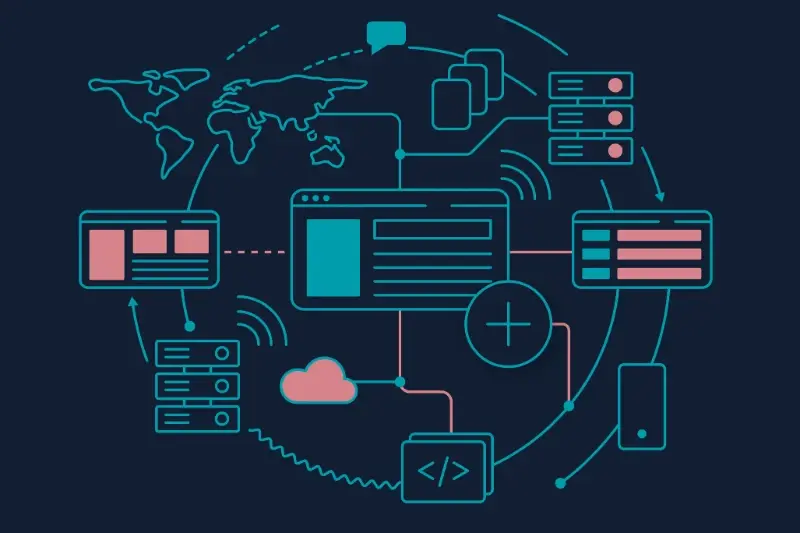How to Build Bulletproof Security Into Your Enterprise Apps
Enterprise apps handle some of the most sensitive data on the planet—customer records, financial information, trade secrets, and personal details that could destroy businesses if they fell into the wrong hands. After building enterprise applications for over eight years, I've watched companies learn this lesson the hard way; what starts as a simple internal tool quickly becomes a treasure trove for cybercriminals who know exactly where to look for vulnerabilities.
The mobile-first world has made enterprise app security more complex than ever before. Your apps aren't just sitting safely behind corporate firewalls anymore—they're running on personal devices, connecting through public WiFi networks, and storing data in cloud services that span multiple countries. Each connection point creates a new opportunity for attackers to slip through the cracks.
Security isn't something you bolt on at the end of development—it needs to be baked into every line of code from day one
Building bulletproof security into enterprise apps requires a completely different mindset than consumer app development. You're not just protecting user experience; you're safeguarding entire organisations from threats that evolve daily. The good news? With the right approach to secure app development and enterprise security implementation, you can create apps that are both user-friendly and fortress-strong against modern cyber threats.
Understanding Enterprise Security Threats
Enterprise apps face a completely different set of security challenges compared to consumer apps—and honestly, the stakes are much higher. We're talking about sensitive business data, financial information, and sometimes personal details of thousands of employees. One security breach can cost millions and destroy years of trust.
The most common threats I see targeting enterprise applications include data breaches through weak authentication systems, man-in-the-middle attacks that intercept communications, and SQL injection attacks that exploit poorly secured databases. Then there's the human element—phishing attacks that trick employees into giving away credentials, and insider threats from disgruntled staff members who already have access.
External vs Internal Threats
External attackers often target APIs and network vulnerabilities, looking for ways to access your systems from the outside. They might use automated tools to find weak spots or launch sophisticated social engineering campaigns. Internal threats, though, can be just as dangerous—employees with legitimate access who misuse their permissions, either maliciously or accidentally.
What makes enterprise security particularly tricky is that these apps need to balance strong protection with usability. Understanding the key differences between business and consumer apps is crucial because you're building defences that need to work in corporate environments where productivity and security must coexist.
Authentication and Access Control
Getting authentication right is probably the most critical security decision you'll make when building your enterprise app. Think of it as the front door to your digital house—you want to be absolutely certain that only the right people can walk through it. Multi-factor authentication has become the gold standard for enterprise app security, and there's a good reason for that.
Single sign-on (SSO) integration makes life easier for your users whilst maintaining tight security controls. When employees can use their existing corporate credentials to access your app, you're reducing password fatigue and the temptation to use weak passwords. Role-based access control takes this a step further by making sure people can only see and do what they're supposed to within your app.
Implementing Secure Authentication
Biometric authentication—fingerprints, face recognition, voice patterns—adds another layer of security that's incredibly difficult to fake. Most modern devices support these features natively, so implementing them in your secure app development process isn't as complex as it once was. Token-based authentication with automatic expiration ensures that even if credentials are compromised, they won't work indefinitely.
Always implement account lockout policies after failed login attempts, but make sure legitimate users aren't locked out permanently—temporary lockouts with progressive delays work best for mobile app security. Consider implementing strong password policies to ensure users create secure credentials from the start.
Data Protection and Encryption
When it comes to protecting sensitive business data, encryption is your app's best friend—and honestly, it should be non-negotiable for enterprise applications. Think of encryption as scrambling your data into a secret code that only authorised people can read. Without the right key, your information looks like complete gibberish to anyone trying to sneak a peek.
Encryption at Rest and in Transit
Your app needs to protect data in two main situations: when it's stored on devices or servers (at rest) and when it's moving between your app and backend systems (in transit). For data at rest, use strong encryption standards like AES-256 to secure databases, files, and any cached information on user devices. This means even if someone gets physical access to a device, they can't easily read the stored data.
For data in transit, always use HTTPS with TLS 1.3 or higher—this creates a secure tunnel for information travelling across networks. I can't stress this enough: never send sensitive data over plain HTTP connections; it's like shouting your secrets in a crowded room.
Key Management
Managing encryption keys properly is just as important as the encryption itself. Store keys separately from encrypted data, rotate them regularly, and use secure key management services provided by cloud platforms. Poor key management is often the weakest link in otherwise solid security systems.
Network Security and APIs
Your enterprise app will need to talk to other systems—there's no getting around it. Whether it's pulling customer data from your CRM or processing payments through a third-party gateway, APIs are the bridges that make everything work. But here's the thing: every connection you make is a potential entry point for attackers.
Securing API Communications
HTTPS isn't optional anymore; it's the bare minimum for any API communication. Every single request between your app and your servers needs to be encrypted. I've seen too many enterprise apps that still use HTTP for "internal" communications, thinking they're safe behind their firewall. That's like leaving your front door unlocked because you live in a nice neighbourhood.
The weakest link in your security chain is often the API endpoint you forgot about six months after launch.
API Authentication and Rate Limiting
Token-based authentication is your friend here—OAuth 2.0 or JWT tokens work brilliantly for most enterprise scenarios. But don't stop there. Rate limiting prevents attackers from hammering your APIs with requests, whilst proper input validation stops malicious data from entering your system. For comprehensive guidance on securing your app's API from unauthorised access, there are specific techniques that can help protect against common attack vectors.
Testing and Monitoring Security
Building secure code is one thing, but knowing it actually works is another entirely. I've seen too many development teams assume their security measures are bulletproof without properly testing them—and that's where things go wrong. Security testing isn't a one-time tick-box exercise; it's an ongoing process that needs to happen throughout your app's lifecycle.
Regular Security Testing
Your security testing should include penetration testing, where ethical hackers try to break into your system to find weaknesses. Code reviews are just as important—having fresh eyes look at your security implementation can catch issues that the original developers missed. Automated security scans can run continuously, checking for known vulnerabilities in your dependencies and codebase.
Real-Time Monitoring
Once your app is live, monitoring becomes your early warning system. Set up alerts for unusual login patterns, failed authentication attempts, or suspicious API calls. Log everything—but make sure you're not logging sensitive data like passwords or personal information. These logs become invaluable when investigating security incidents.
The key is making security testing and monitoring part of your regular development workflow, not something you bolt on at the end. If you're looking for comprehensive guidance on ensuring your app remains secure throughout its lifecycle, implementing proper testing and monitoring practices is essential for maintaining user trust.
Conclusion
Building bulletproof enterprise app security isn't something you can tick off a list and forget about—it's an ongoing commitment that needs to be baked into every part of your development process. From the moment you start sketching out your app's architecture to the day you push it live and beyond, security needs to be front and centre of every decision you make.
The threats facing enterprise applications are real and they're getting more sophisticated every day. But here's the thing—you don't need to be a security expert to build secure apps. You just need to follow the fundamentals we've covered: strong authentication and access controls, proper data encryption, secure API practices, and continuous testing and monitoring. Each of these elements works together to create layers of protection that make your app incredibly difficult to compromise.
What I've learned from years of building enterprise apps is that security isn't about being paranoid or making things complicated for users. It's about being smart and proactive. When you implement enterprise app security correctly, users barely notice it's there—but hackers definitely will. The investment you make in secure app development today will save you from much bigger headaches (and costs) down the road. Your users trust you with their data, and that's not something to take lightly.
Share this
Subscribe To Our Blog
You May Also Like
These Related Stories

Building Bulletproof APIs: Technical Architecture For Enterprise Apps

API Security For Mobile Apps: Protecting Your Users And Your Business





